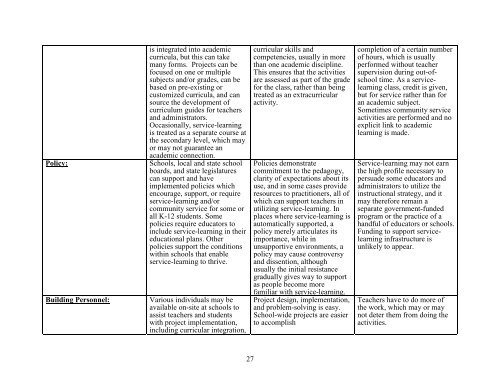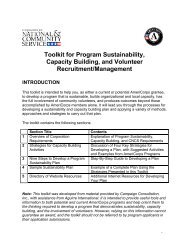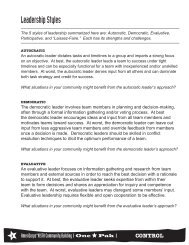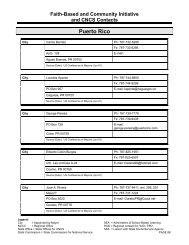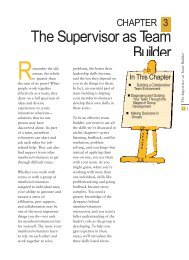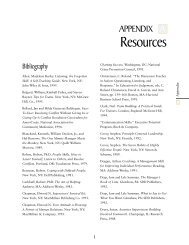MAKE IT LAST FOREVER: THE ... - National Service Resource Center
MAKE IT LAST FOREVER: THE ... - National Service Resource Center
MAKE IT LAST FOREVER: THE ... - National Service Resource Center
You also want an ePaper? Increase the reach of your titles
YUMPU automatically turns print PDFs into web optimized ePapers that Google loves.
is integrated into academic<br />
curricula, but this can take<br />
many forms. Projects can be<br />
focused on one or multiple<br />
subjects and/or grades, can be<br />
based on pre-existing or<br />
customized curricula, and can<br />
source the development of<br />
curriculum guides for teachers<br />
and administrators.<br />
Occasionally, service-learning<br />
is treated as a separate course at<br />
the secondary level, which may<br />
or may not guarantee an<br />
academic connection.<br />
Policy: Schools, local and state school<br />
boards, and state legislatures<br />
can support and have<br />
implemented policies which<br />
encourage, support, or require<br />
service-learning and/or<br />
community service for some or<br />
all K-12 students. Some<br />
policies require educators to<br />
include service-learning in their<br />
educational plans. Other<br />
policies support the conditions<br />
within schools that enable<br />
service-learning to thrive.<br />
Building Personnel: Various individuals may be<br />
available on-site at schools to<br />
assist teachers and students<br />
with project implementation,<br />
including curricular integration,<br />
27<br />
curricular skills and<br />
competencies, usually in more<br />
than one academic discipline.<br />
This ensures that the activities<br />
are assessed as part of the grade<br />
for the class, rather than being<br />
treated as an extracurricular<br />
activity.<br />
Policies demonstrate<br />
commitment to the pedagogy,<br />
clarity of expectations about its<br />
use, and in some cases provide<br />
resources to practitioners, all of<br />
which can support teachers in<br />
utilizing service-learning. In<br />
places where service-learning is<br />
automatically supported, a<br />
policy merely articulates its<br />
importance, while in<br />
unsupportive environments, a<br />
policy may cause controversy<br />
and dissention, although<br />
usually the initial resistance<br />
gradually gives way to support<br />
as people become more<br />
familiar with service-learning.<br />
Project design, implementation,<br />
and problem-solving is easy.<br />
School-wide projects are easier<br />
to accomplish<br />
completion of a certain number<br />
of hours, which is usually<br />
performed without teacher<br />
supervision during out-ofschool<br />
time. As a servicelearning<br />
class, credit is given,<br />
but for service rather than for<br />
an academic subject.<br />
Sometimes community service<br />
activities are performed and no<br />
explicit link to academic<br />
learning is made.<br />
<strong>Service</strong>-learning may not earn<br />
the high profile necessary to<br />
persuade some educators and<br />
administrators to utilize the<br />
instructional strategy, and it<br />
may therefore remain a<br />
separate government-funded<br />
program or the practice of a<br />
handful of educators or schools.<br />
Funding to support servicelearning<br />
infrastructure is<br />
unlikely to appear.<br />
Teachers have to do more of<br />
the work, which may or may<br />
not deter them from doing the<br />
activities.


